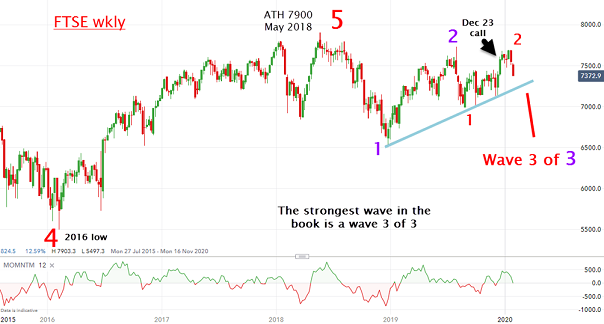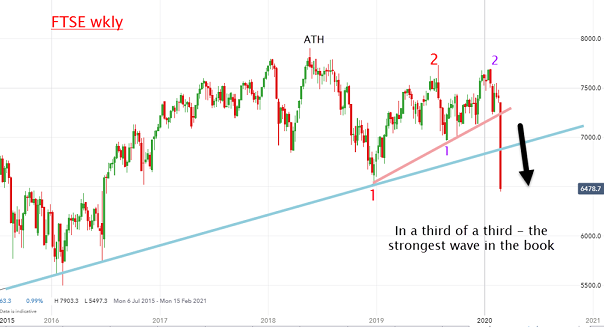If FTSE 100 is in a bear trend, how low can it go?
Amid bargain hunting after last week’s crash, this successful chartist gives his verdict on prospects.
2nd March 2020 10:20
by John Burford from interactive investor
Amid bargain hunting after last week’s crash, this successful chartist gives his verdict on prospects.

Regular readers of Chart of the week (COTW) will know that I have been maximum bearish on the FTSE 100 for some time. So, the huge and ‘sudden’ collapse last week should not be a surprise (although it is to many judging by the mainstream headlines about the virus).
Here is what I wrote a month ago in my COTW of 3 February: “In fact, in my recent COTW of December 23 as I reviewed the FTSE charts, this is what I wrote: I expect a bear market in 2020. That was no sit-on-the-fence ‘will it, won’t it’ that permeates so much market analysis. And it flew in the face of many pundits’ claims that the ‘Boris Bounce’ would ensure smooth sailing for the UK economy after Brexit as the floodgates of delayed investments are suddenly flung open.
“I am maximum bearish. The bottom line: This may be a great time to consider raising cash.”
Here is the chart I showed in February:

Source: interactive investor Past performance is not a guide to future performance
My December bearish call was pips away from the ultimate high at 7,690 and, by early February, the rot had started to set in. Note that the widely forecast target at 7,700 was not quite hit. Many prominent pundits offered this target.
I have found over the years that when a round-number target is widely accepted, the market obliges by gunning for it – and then swerving just before it is reached. All profit-take orders at 7,700 were never filled – and disappointed a great many traders anxious to cash in! The market is a cruel master, unless you anticipate its sometimes perverse moves, of course.
So, has the intervening action validated my very bearish December call? Recall I expected a hard down in a ‘third of a third’ wave. Here is that chart updated:

Source: interactive investor Past performance is not a guide to future performance
I believe there is little doubt it has, with the market breaking below the red wave1 low at 6,525. Last week, it lost a staggering 900 points (12%).
So I am sure many are asking – how did he know a virus from China would come out of left field in mid-January and pour cold water all over the lovely bull run we enjoyed all of last year – and claim he nailed the top back in December with almost perfect timing?
Believe me, I would love to claim that I had inside information that a tiny virus would slam the door so hard on global economic growth. But if I had that it would have been illegal, of course.
No, the virus manifested at just the right time to reflect the state of social mood. It had been trending darker for months and, with our weaker immune systems, many of us are receptive to attack from a new virus.
- How Lloyds Bank shares can recover coronavirus losses
- Will these ten stocks make the Decision Engine?
- Take control of your retirement planning with our award-winning, low-cost Self-Invested Personal Pension (SIPP)
And this throws up a stark validation of the old saw: ‘Major market moves don’t repeat exactly, but they do rhyme’. In 2008 – the previous crash – the headline ‘cause’ was the collapse of the NINJA (No Income No Job No Assets) loans to indigent US homeowners. This time the headline is the coronavirus.
But the effect on the market is the same every time because Elliott wave patterns work through consistently. This current ‘third of a third’ repeats the pattern of such waves – devastation in a bear market.
At this point I am unable to say with any confidence where this wave will terminate, but it will. Third waves often carry much farther than reason suggests.
But the die is cast – we are in a strong bear trend than will not end for months, if not years. We will see sharp upward reversals – one may have stated this morning – but the trend is now down.
Another worrying trend is the ‘sudden’ reversal down in the ‘safe haven’ precious metals, especially gold (which dropped a huge $80 on Friday).
Suddenly, safe havens are no longer safe. And this points to one thing – we are starting a deflationary recession where asset prices will be squeezed.
For more information about Tramline Traders, or to take a three-week free trial, go to www.tramlinetraders.com.
John Burford is the author of the definitive text on his trading method, Tramline Trading. He is also a freelance contributor and not a direct employee of interactive investor.
These articles are provided for information purposes only. Occasionally, an opinion about whether to buy or sell a specific investment may be provided by third parties. The content is not intended to be a personal recommendation to buy or sell any financial instrument or product, or to adopt any investment strategy as it is not provided based on an assessment of your investing knowledge and experience, your financial situation or your investment objectives. The value of your investments, and the income derived from them, may go down as well as up. You may not get back all the money that you invest. The investments referred to in this article may not be suitable for all investors, and if in doubt, an investor should seek advice from a qualified investment adviser.
Full performance can be found on the company or index summary page on the interactive investor website. Simply click on the company's or index name highlighted in the article.
Disclosure
We use a combination of fundamental and technical analysis in forming our view as to the valuation and prospects of an investment. Where relevant we have set out those particular matters we think are important in the above article, but further detail can be found here.
Please note that our article on this investment should not be considered to be a regular publication.
Details of all recommendations issued by ii during the previous 12-month period can be found here.
ii adheres to a strict code of conduct. Contributors may hold shares or have other interests in companies included in these portfolios, which could create a conflict of interests. Contributors intending to write about any financial instruments in which they have an interest are required to disclose such interest to ii and in the article itself. ii will at all times consider whether such interest impairs the objectivity of the recommendation.
In addition, individuals involved in the production of investment articles are subject to a personal account dealing restriction, which prevents them from placing a transaction in the specified instrument(s) for a period before and for five working days after such publication. This is to avoid personal interests conflicting with the interests of the recipients of those investment articles.